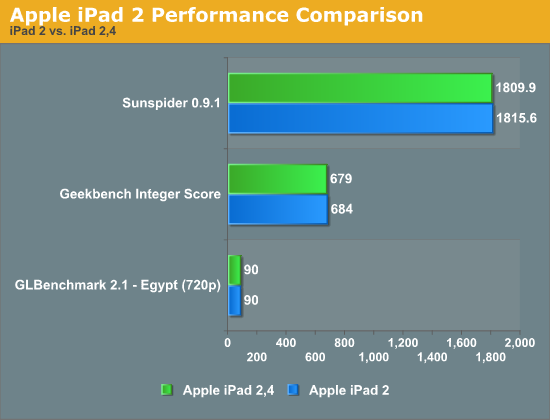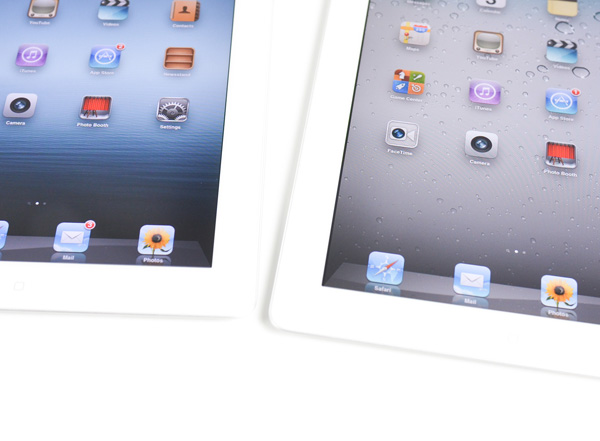The iPad 2,4 Review: 32nm Brings Better Battery Life
by Anand Lal Shimpi on May 4, 2012 12:50 AM ESTDecreased Power Consumption
We obviously know the impact of the new SoC on battery life but here's a look at just how much less power the new platform draws in various conditions. Note that for whatever reason the iPad's power consumption when sitting at the home screen is actually higher than when running our 720p High Profile video playback test. The results were consistent as I tested multiple times across multiple iPads. I have a few thoughts as to what could be happening here:
| Tablet Power Consumption (including Display) | ||||||
| iPad 2,4 | iPad 2 | iPad (3rd generation) | ||||
| Homescreen | 2.7 W | 2.9 W | 6.1 W | |||
| Sunspider | 3.4 W | 4.3 W | 7.6 W | |||
| Moonbat (20 x 4) | 3.9 W | 5.0 W | 8.3 W | |||
| GLBench Egypt (native res) | 3.8 W | 4.5 W | 9.6 W | |||
| GLBench Egypt (offscreen 720p) | 4.1 W | 4.8 W | 10.0 W | |||
| Infinity Blade 2 | 4.3 W | 5.1 W | 10.3 W | |||
| Riptide GP | 3.9 W | 4.7 W | 10.2 W | |||
| Video Playback (720p HP) | 2.2 W | 2.4 W | 4.9 W | |||
Under heavy CPU load (multithreaded Sunspider) we see a 28% increase in power consumption from the 45nm iPad 2,1 compared to the newer 2,4. Keep in mind that we're looking at peak power consumption here, which helps explain the smaller gap on the GPU side than what we saw in our battery life tests. What this data does show however is that the power efficiency improvements can be just as significant for CPU bound workloads, it's simply harder to find workloads that are CPU bound for long periods of time.
Looking at the 3rd generation iPad data reminds us of just how power hungry that platform is. It truly is Apple's performance halo, and it's the perfect target for a 32nm SoC in the future.
The iPad 2 battery life comparison numbers were generated on a lightly used iPad 2 with fewer than 20 charge cycles. While it's possible that some of the differences highlighted on the previous page are due to differences in the batteries between these two devices, it's likely that the variance is in the single digit range at best due to the limited number of charge cycles on the iPad 2 (Update: we confirmed the delta between our iPad 2 results and a brand new, out of box 45nm iPad 2 was < 3%). The power consumption numbers above remove the battery from the equation and help to validate these numbers.
Slightly Improved Thermals
I ran the same temperature test I did for our iPad review: measure maximum surface temperature of the tablet after a 1 hour loop of Infinity Blade 2. The results aren't surprising:
| Thermal Comparison (Max Temperature) | ||||||
| iPad 2,4 | iPad 2 | iPad (3rd generation) | ||||
| Infinity Blade 2 (1 hour) | 33.2˚C | 34.2˚C | 41.9˚C | |||
The iPad 2,4 manages to shave off a degree of surface temperature. It's not really noticeable, but it's there.
Performance
There's no performance difference between the iPad 2,4 and the older iPad 2 models. Regardless of whether you're looking at CPU or GPU performance, the new and older iPad 2s are indistinguishable. Apple definitely embraced the console mentality with this launch.

One difference you will notice between iPads however is variance in the panel vendor and resulting performance. Similar to what we've reported on in the Mac space, Apple likes to get 2 - 3 vendors for most components with very few exceptions (e.g. the CPU/GPU/SoC). We've seen this primarily be an issue with displays and storage devices in Macs, but on the iPad/iPhone side of the fence it can definitely be noticeable as the display plays such a major role in the experience with these devices.
The iPad 2,4 I'm reviewing has noticeably different display characteristics compared to my older iPad 2. My 2,4 sample has a higher maximum brightness (and black level), better grayscale color accuracy, and lower color temperature (more yellow). The new panel isn't any worse than what we've reviewed previously, in fact it's actually slightly better in a number of areas, although some users may be put off by the lower white point temperature (6200K vs. 6600K).
The panel I ended up with here isn't specific to the 2,4, but rather something you could end up with in any iPad 2 model. This is nothing new, but it's always interesting to get an idea of the amount of variance Apple considers acceptable. The new iPad still appears to be in the single or dual source stage (there's conflicting information about whether or not LG made panels are also available today). Sharp is expected to come online in the near future as another source. It remains to be seen how those panels will fare compared to the excellent Samsung panel that Apple launched with however.











100 Comments
View All Comments
dagamer34 - Friday, May 4, 2012 - link
It's kind of a shame that Samsung wasn't ready to product a 32nm A5X for the new iPad. While it's obvious that most of the battery life "issues" come from the amount of power the backlight consumes, a cooler running SoC would have been much appreciated.PeteH - Friday, May 4, 2012 - link
I doubt Apple would risk an entirely new SoC on an unproven process. If the 32nm A5 had been delayed because of process issues they could just keep manufacturing 45nm A5s and shipping iPad 2s. If a 32nm A5X is delayed, you slip the iPad 3.Samus - Friday, May 4, 2012 - link
dagamer34, the backlighting in the new iPad consumes the same amount as any other screen in any other iPad. I assume what you are trying to say is the screen is where most power consumption is used, which is correct, and the case with almost all mobile devices.The new iPad does need a die shrink, though, that's for sure. The GPU portion of the A5X consumes around 30% of the battery alone when driving full resolution graphics, which is why it has 30% less battery life than the iPad 2.
sigmatau - Friday, May 4, 2012 - link
That didn't make much sense. The iPad 3 also has a battery that's almost double the iPad 2.j2ozone - Friday, May 4, 2012 - link
The display has 4x as many pixels > which means it has 4x as much pixel wiring > which absorbs 4x as much of the backlight as older ipad display wiring > which means the backlight has to be brighter > which uses more power.mbzastava - Friday, May 4, 2012 - link
It is not the backlight that is making the huge difference in power draw. it is the quad-core gpu that is working 4 times harder than the dual-core gpu it replaced. all backlighting is done via edge-lighting, and the delta in power consumption to step up to a marginally brighter output is negligible considering the doubling of the battery capacity (doubly especial since LEDs are already pretty efficient). If you have ever taken apart laptop LCD screens you would understand.frostyfiredude - Saturday, May 5, 2012 - link
There is a more beefy backlight for the reason ozone said, go look at the review of the 3rd gen iPad and you'll see how large an effect bumping up the brightness causes compared to in previous iPads.Another way to see this is by looking at the numbers in this review where power use between the iPad 3,1 2,1 and 2,4 are compared. In H.264 playback the GPU and CPU are both doing essentially nothing so it isolates the screen fairly effectively. At the same brightness iPad 3,1 uses 4.9W, iPad 2,1 uses 2.4W and iPad 2,4 uses 2.2W. This shows that the display uses around 2.5W more power at the chosen brightness level. Looking at the same chart the GPU appears to be pulling about 2W extra (assuming moonbat works the CPU as hard as infinity blade 2).
Steelbom - Friday, May 4, 2012 - link
The iPad 3's display does actually consume a lot more power than the iPad 2's display, coming in at 7 watts per hour compared to only 2.7 watts per hour, both at max brightness.I'd say the A5 uses at most 3w when under load, and I'd give the A5X about 4w.
http://www.displaymate.com/iPad_ShootOut_1.htm
(Scroll to the bottom and then up until you find the power consumption graphics.)
victorengel - Monday, July 16, 2012 - link
Something is wrong. Your units don't make any sense. Perhaps you meant watts rather than watts per hour?lolstebbo - Friday, May 4, 2012 - link
I think you can tell if it's a 2,4 or not: presumably, only the 2,4 models would have the iCloud logo on the box.